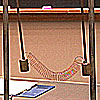-

-
Courses
Find courses by:
Collections
Cross-Disciplinary Topic Lists
- About
- Donate
- Featured Sites

 |
|
By the end of this lecture, you should:
› View/hide answer
Most simply, all three pendulums can move identically with angular frequency \(\sqrt {\frac{g}{l}}\)and no stretching of the springs. Another simple motion is the two outer pendulums moving out of phase with each other with the inner one stationary. The similarity of each side of this situation to a double pendulum leads us to conclude that the angular frequency would be \[\sqrt {{{\left( {\frac{g}{l}} \right)}^2} + \alpha {{\left( {\frac{k}{m}} \right)}^2}} \] which is higher than the in-phase mode due to the involvement of the springs. The positive constant α would need to be determined by more detailed analysis.
› View/hide answer
The period to return to the same situation would be 20 seconds if the energy goes from one to the other in 10 seconds and the slow term angular frequency for each bob is \(\frac{{{\omega _ + } - {\omega _ - }}}{2}\), corresponding to \[\frac{{2\pi }}{T} \approx \frac{{6.3}}{{20}} = 0.3rad/s.\] For a one meter spring \[{\omega _0} = {\omega _ - } = \sqrt {\frac{g}{l}} \approx 3.1 rad/s.\] This gives \({\omega _ + } = 2(0.3) + {\omega _ - } = 3.7rad/s.\) But \({\omega _ + } = \sqrt {2\omega _s^2 + \omega _0^2} \) or \[\omega _s^2 = \frac{{\omega _ + ^2 - \omega _0^2}}{2} = \frac{{{{3.7}^2} - {{3.1}^2}}}{2} = 2\] Since \(\omega _s^2 = \frac{k}{m}\) we have \(k = 0.5(2) = 1\) N/m, a rather weak spring as the ones in the video look to be. However, we note that they are also drooping, so their mass moving up and down may also affect the frequency.